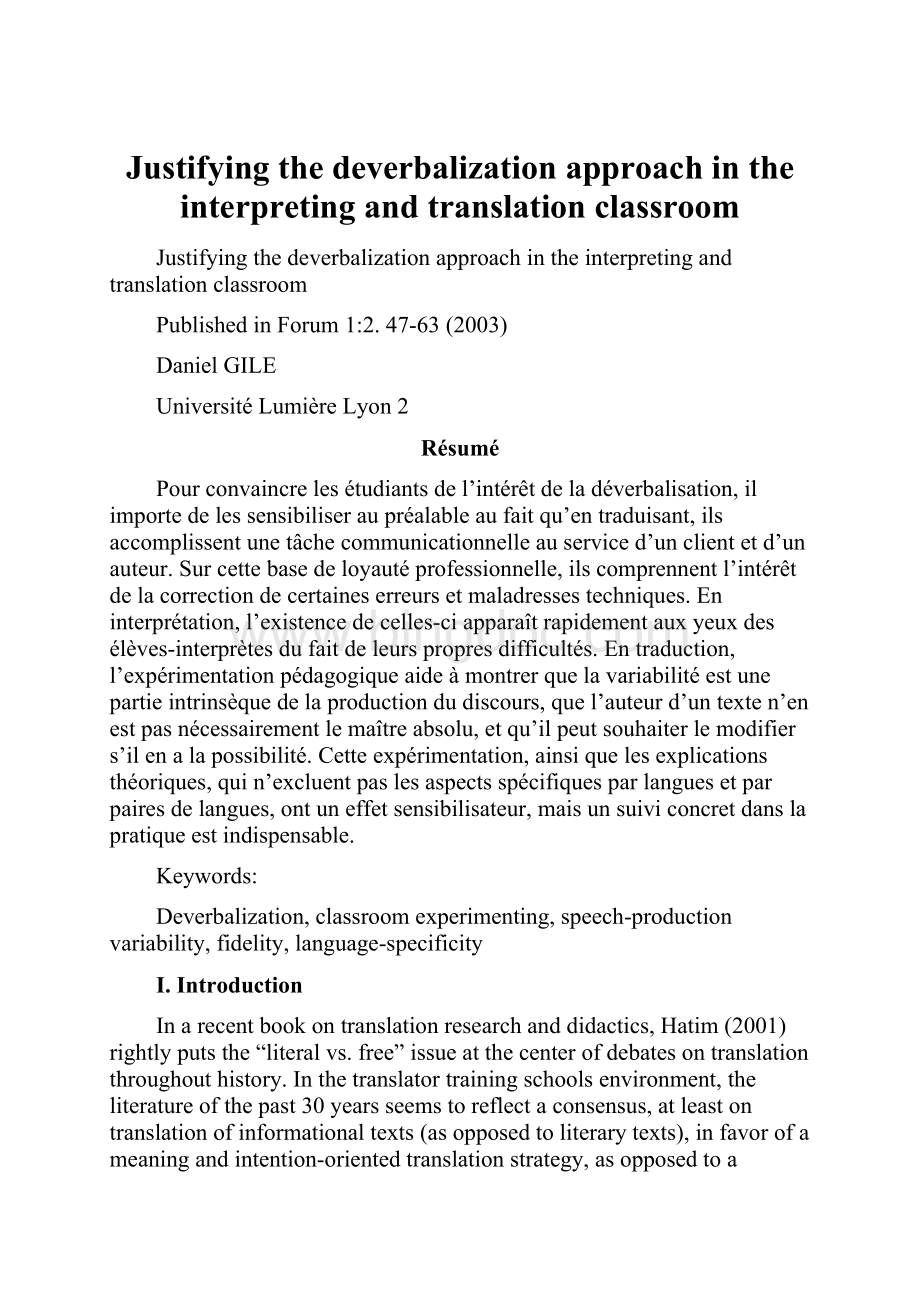Justifying the deverbalization approach in the interpreting and translation classroomWord格式.docx
《Justifying the deverbalization approach in the interpreting and translation classroomWord格式.docx》由会员分享,可在线阅读,更多相关《Justifying the deverbalization approach in the interpreting and translation classroomWord格式.docx(16页珍藏版)》请在冰点文库上搜索。

Ré
sumé
Pourconvaincrelesé
tudiantsdel’inté
rê
tdeladé
verbalisation,ilimportedelessensibiliseraupré
alableaufaitqu’entraduisant,ilsaccomplissentunetâ
checommunicationnelleauserviced’unclientetd’unauteur.Surcettebasedeloyauté
professionnelle,ilscomprennentl’inté
tdelacorrectiondecertaineserreursetmaladressestechniques.Eninterpré
tation,l’existencedecelles-ciapparaî
trapidementauxyeuxdesé
lè
ves-interprè
tesdufaitdeleurspropresdifficulté
s.Entraduction,l’expé
rimentationpé
dagogiqueaideà
montrerquelavariabilité
estunepartieintrinsè
quedelaproductiondudiscours,quel’auteurd’untexten’enestpasné
cessairementlemaî
treabsolu,etqu’ilpeutsouhaiterlemodifiers’ilenalapossibilité
.Cetteexpé
rimentation,ainsiquelesexplicationsthé
oriques,quin’excluentpaslesaspectsspé
cifiquesparlanguesetparpairesdelangues,ontuneffetsensibilisateur,maisunsuiviconcretdanslapratiqueestindispensable.
Keywords:
Deverbalization,classroomexperimenting,speech-productionvariability,fidelity,language-specificity
I.Introduction
Inarecentbookontranslationresearchanddidactics,Hatim(2001)rightlyputsthe“literalvs.free”issueatthecenterofdebatesontranslationthroughouthistory.Inthetranslatortrainingschoolsenvironment,theliteratureofthepast30yearsseemstoreflectaconsensus,atleastontranslationofinformationaltexts(asopposedtoliterarytexts),infavorofameaningandintention-orientedtranslationstrategy,asopposedtoastrategybasedonformalequivalence:
itisfeltthattranslationsufferswhenitisconstructedonlinguisticcorrespondences,andservesitspurposebetterwhentheformofthesourcetextisusedtounderstanditandisthenhonorablydischargedwhilethereformulationprocessproceedsonthebasisofanautonomousmentalrepresentationofitsmeaning(informational,emotional,social,intentional,etc.).AspointedoutbyPö
chhacker(1994:
22),morethan40yearsago,Wirl(1958:
23)talkedaboutthetranslatoroperatingmostlyonthebasisofthecontent(“sense”)ofthesourcetext
strippedofitslinguisticform(“vomWortlautschongelö
st,alsoentsprachlicht”).Twodecadeslater,SeleskovitchandLedererofESIT,Paris,madethis“deverbalization”principlethefoundationoftheir“theoryofsense”(“thé
oriedusens”).Intheliterature,thereissomeuncertaintyastothestatusofthisconcept:
isitsupposedtobetotalorpartial(Laplace2002:
197,Setton2003),descriptiveorprescriptive?
Myfeeling,somewhatdifferentfromKarlaDé
jeanLeFé
al’s(2002:
146),isthatthe“theoryofsense”isonlychallengedbyitscriticsasadescriptivetheoryintheusualscientificsenseoftheword,butthatitiswidelysupportedasaprescriptiveparadigm,thatis,adesirableapproachtotranslation.Thispaperdiscussesstrategiesforjustifyingsuchanapproachtostudentsintheclassroom.
II.Translator-rolepostulates
LikemanyotherauthorsandTranslationinstructors(“Translation”withacapitalTwillbeusedtorefertobothtranslationandinterpreting;
similarly,“Translators”willrefertotranslatorsandinterpreters,and“Texts”willrefertotextsandspeeches),IbelievethatprescriptivestatementsaboutTranslationstrategiesaremostconvincingiftheyarebasedonaclearideaaboutthecommunicativeroleofTranslation,thatis,ifitismadecleartostudentsthatintheworldofprofessionalTranslation,mostoften,andnearlyalwayswhentranslatingnon-literarytexts,Translatorsareexpectedtoservenottexts,butpeople,withparticularintentionsandinterests.
Explanationscanbe“theoretical”,forinstanceusingthe“skopostheory”(seeforexampleReissandVermeer1984,Schä
ffner1998).Inanacademicenvironment,muchcanbesaidinfavorofsomeabstractthinkingandtheorizing.However,inthecontextofshort,moreprofessionallyorientedprograms,astraightforward,down-to-earthapproachisprobablymoreefficient:
whenstudentsaretoldaboutthereal-lifecircumstancesthatleadtoaTranslationassignment,itbecomesclearertothemthattheyareaskedtoTranslateprimarilyinordertohelpusersoperateamachine,tohelparesearcherpresentandexplainhis/hertheoryorfindingstofellow-researchers,tohelpaCEOpresentanddefendhisbusinessstrategytodirectorsandshareholders,tohelpacompanysellitsproducts,etc.ItalsobecomesclearertothemthattheTranslation
commissionerisgenerallynotthespeakerortheauthorofthetextbutanintermediary,whoseprimaryinterestsmaybetoservetheinterestsofthespeakerorauthorortheirorganization’s,butmayjustasoftenbepurelycommercial.
ThedefaultparametersIdefineintheclassroomafterdiscussionofothercasespositaTranslationdoneattherequestofaTranslationcommissioner(the“Client”)withthepurposeofconveyingtotarget-languagereadersorlistenerstheauthor’sorspeaker’smessage,bothintermsoftheinformationthats/heintendsthemtoreceiveandintermsoftheeffect(s)thats/heistryingtoachieve.Thus,theTranslator’sprofessionalloyaltyisduebothtotheClient,byvirtueoftheprofessionalrelationshiptheyenterinto,andtotheauthororspeaker,whomtheTranslatorrepresents,mostofteninatransparentway,atleastinwritten,non-literarytranslation:
readersmayhavetheknowledgethattheyarereadingatranslation,butnottheconstantawarenessofthefact,andfeelthattheyarereadingtheauthor’stext,notthetranslator’s.Inthemostfrequentcase,theClient'
saimsarenotincompatiblewiththeauthor/speaker’s,whichmeansthattheTranslatorisfreetodevotehis/hereffortstoservetheauthor’s/speaker’sinterests(differentsituations,wheretheTranslatorservesnottheauthor,butathirdparty,alsooccur-seeGile1995).
Onceprofessionalloyaltyisseenasservingtheauthorofamessage,whosetextorspeechistheverbalobjectdesignedtoservehis/herintentiontoproducecertaineffectsonreaders/listeners,andunderthedefaultassumptionthattheauthor'
sinterestsdonotclashwiththeClient’s,itbecomeseasytoidentifycertaincaseswheretheTranslatorcanjustifiablydepartfromthesourceText.Inparticular,whenitcontainsamistakewhichcanreasonablybeassumedtoresultfromatechnicalproblem(suchasatypo)orfromtheauthor’sinsufficientmasteryofthesource-textlanguage,itiseasytodefendtheideathattheTranslatordoeshis/herworkbestifs/hecorrectsitinthetargetText.Similarly,ifaTextisambiguousandthereisnoreasontobelievethisisduetotheauthor’sintentiontobevague,studentscanbepersuadedthattheywillservesuchanauthor’sintentionsandinterestsbestbyremovingtheambiguity.
Overthepasttenyearsorso,IhavebeencollectingauthenticTextswitherrorsandambiguouspassagesforclassroomdemonstrations.SuchTextscanbefoundinthecourseofone’sTranslationwork(forinterpreting,speechesmayberecorded,bothintheconferenceroom-withtherelevantpersons’permission,orfromradioandTVbroadcasts).Instructorsnotcurrentlyengagedinprofessionaltranslationcanlookforsuitableexamplesinscientificpapers,whichareoftenwrittenbynonnativespeakers,andinparticularinabstracts.
Inthetranslationclassroom,inordertosavetime,thewholetextispresentedtostudents,buttheyareaskedtotranslateonlyshortpassageswhichareparticularlyproblematic,soastoraisetheirawarenessofsuchproblemsin“official”printedmaterial,whichmanyofthemtendtoconsidererror-free(“Ithasbeenpublished,soitmustbegood”).
Oneparticularstrikingexamplewasfoundontheinternetrecently,inthebiographyofapersonality:
(accessedonOctober14,2000),wherethefollowingtwosentenceswerefound:
“HeisqualityofknowledgeisaMujjahidMurakkihJuristicScholarsabletooutweighbetweenthefourIslamicSchoolsofthought:
Hanafi,Maliki,Shaffi’ieandHanbali.”
........
“HeisthefounderofHizbut-TahrirUkbranchandthefounderofAl-Muhajirounworld-wild.”
ItwasobviousforthestudentsthatiftheywereaskedtotranslatethisWeb-pageintoFrenchforthepurposeofservingtheinterestsofitsauthors,theyhadtomakesenseoutofitandcorrectit.
III.Justifyingadeverbalizationapproachininterpretingclasses
OnceTranslationisunderstoodasacommunicationserviceassetoutinSectionIIabove,justifyingdeverbalizationintheinterpretingclassroomisrelativelyeasy,becausestudentsrealizewithinaveryshorttimehowcomplexanddifficultspeechproductioncanbeandhowofteninfelicitiesandevenerrorsoccurinspontaneousspeech.Notonlydotheyobservetheminotherspeakers,buttheypainfullyexperiencethemintheirownspeechproduction.ThedeteriorationoflinguisticoutputqualityinstudentsspeakingtheirnativelanguageduringexercisesinconsecutiveinterpretingwasoneofthephenomenaIfoundmoststrikingwhenIwasafirstyearinterpretingstudent
myself;
itlaterbecamethefocusofanempiricalstudyinwhichIuseditasanindicatoroftherelativedifficultyofconsecutiveandsimultaneousinterpreting(Gile1987).
Onceinterpretingstudentsareawareofthesedifficulties,theycanextrapolateonthebasisoftheirownexperienceandunderstandinaveryconcrete,personalway,reinforcedwithmanyfieldobservations,howstress,ortheinfluenceofaforeignlanguageintheimmedia